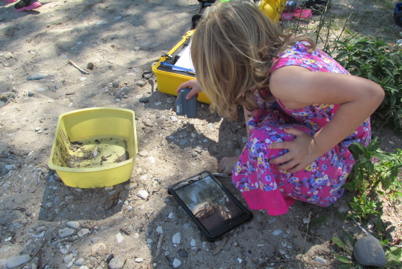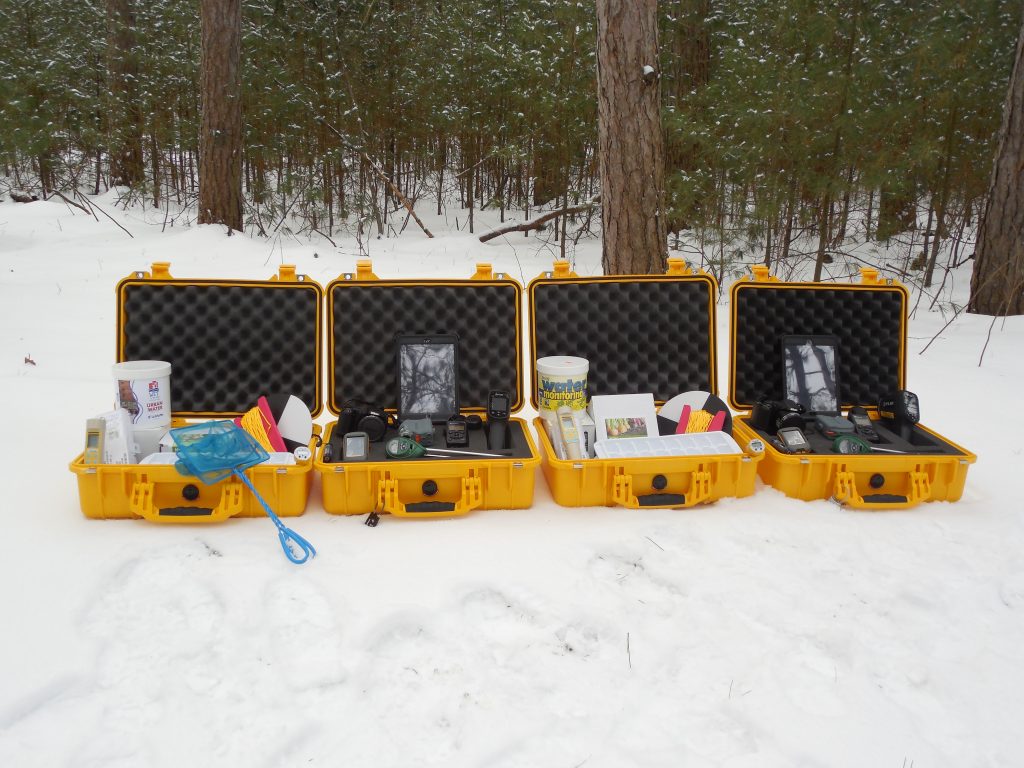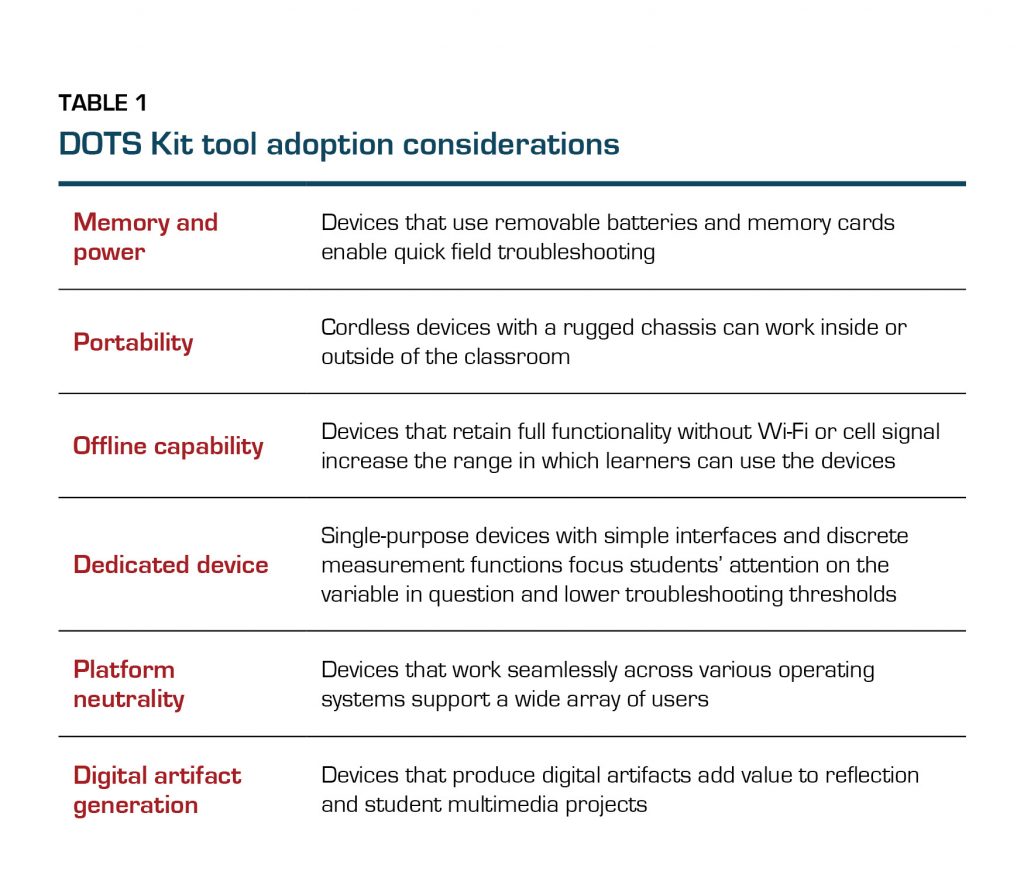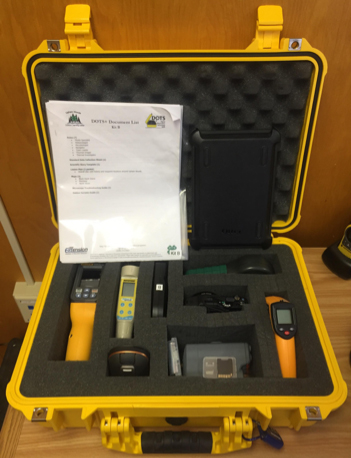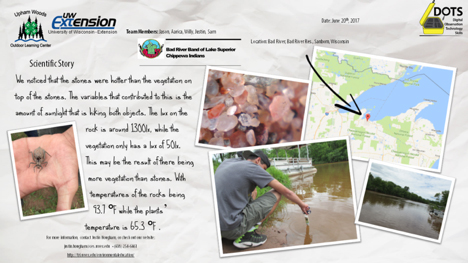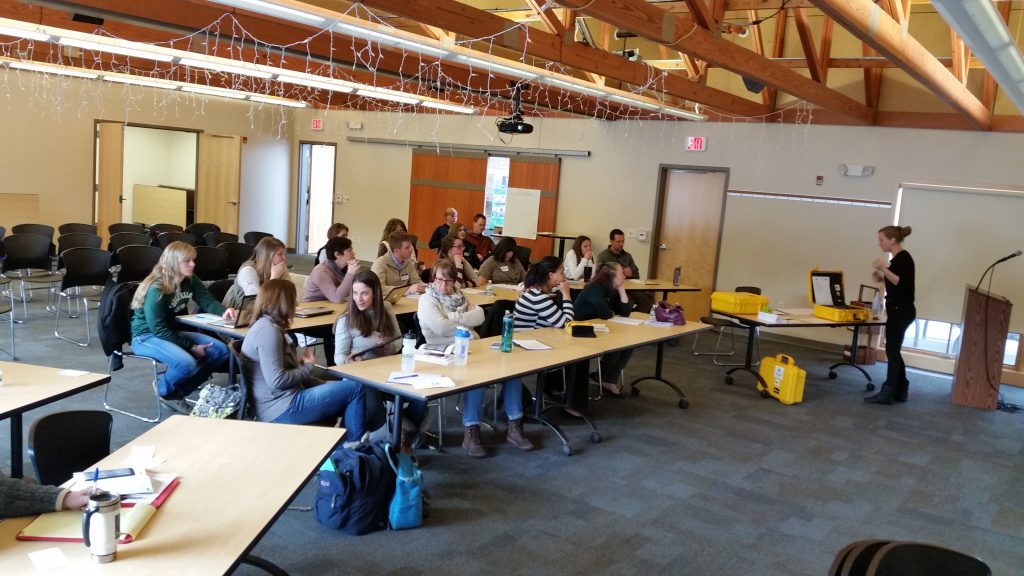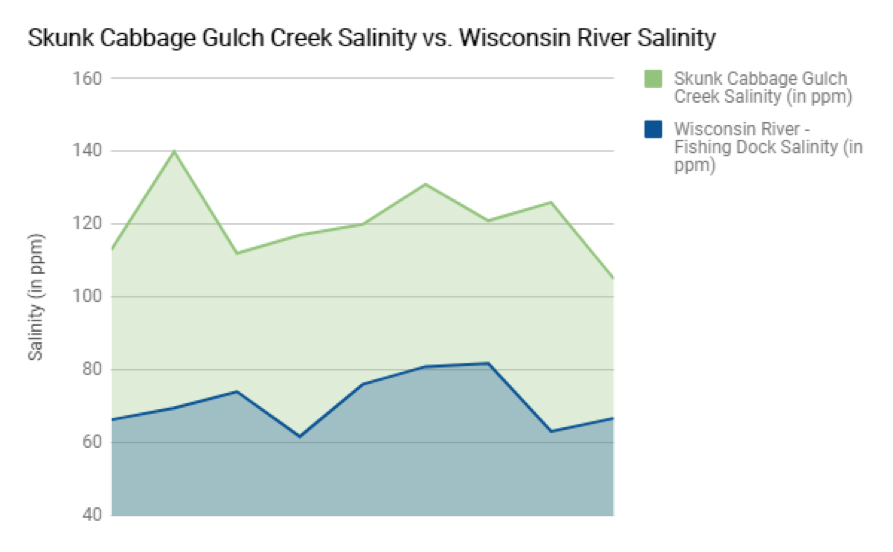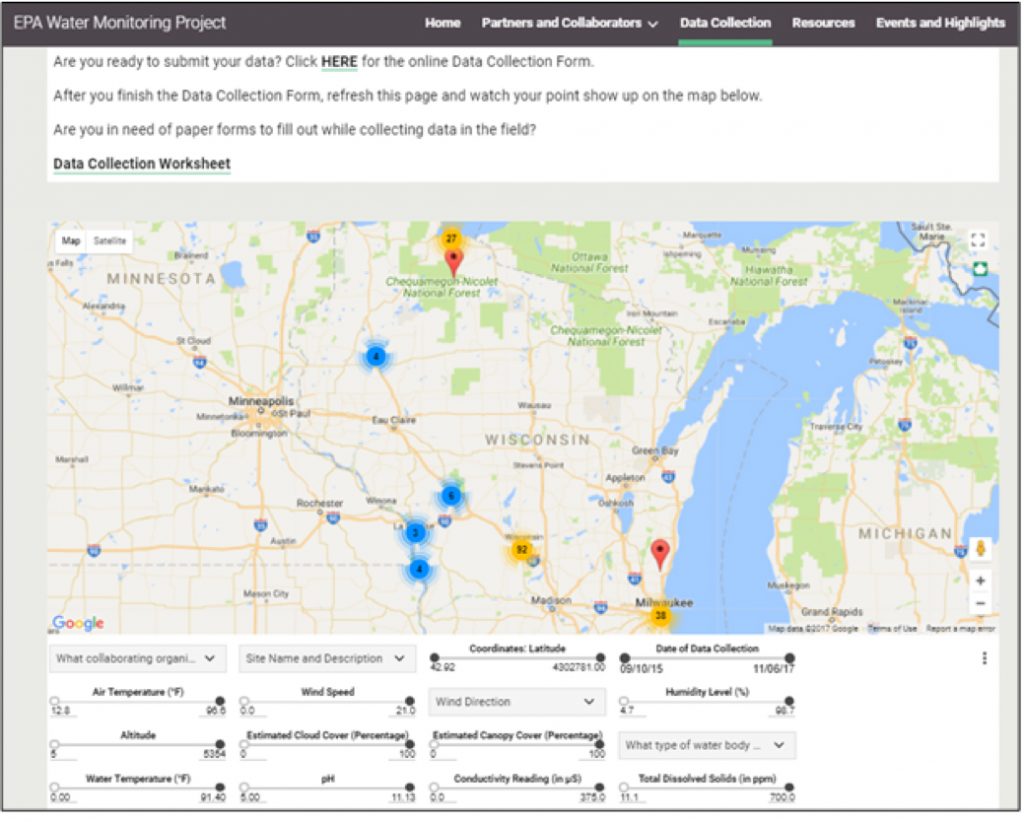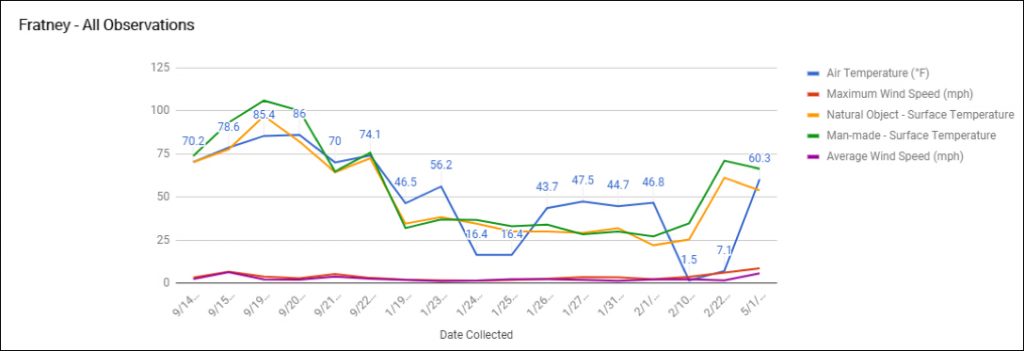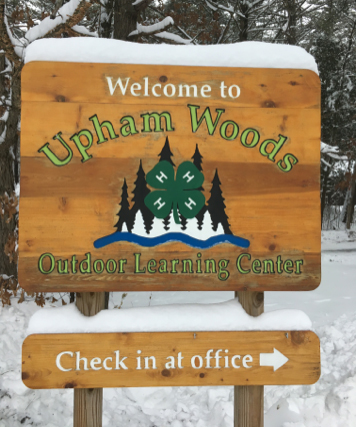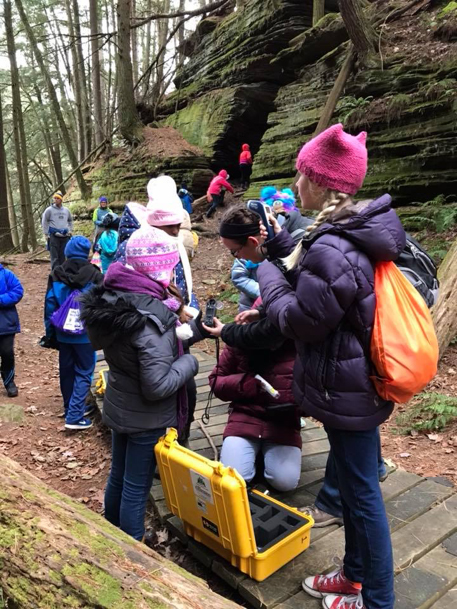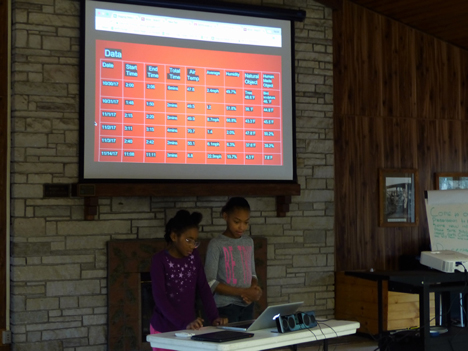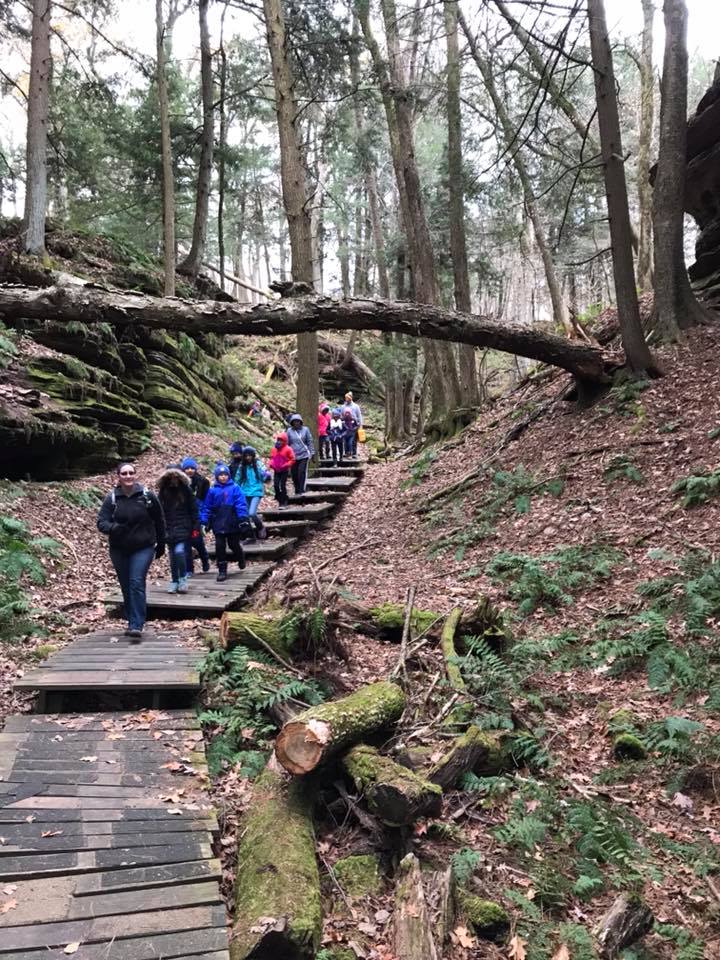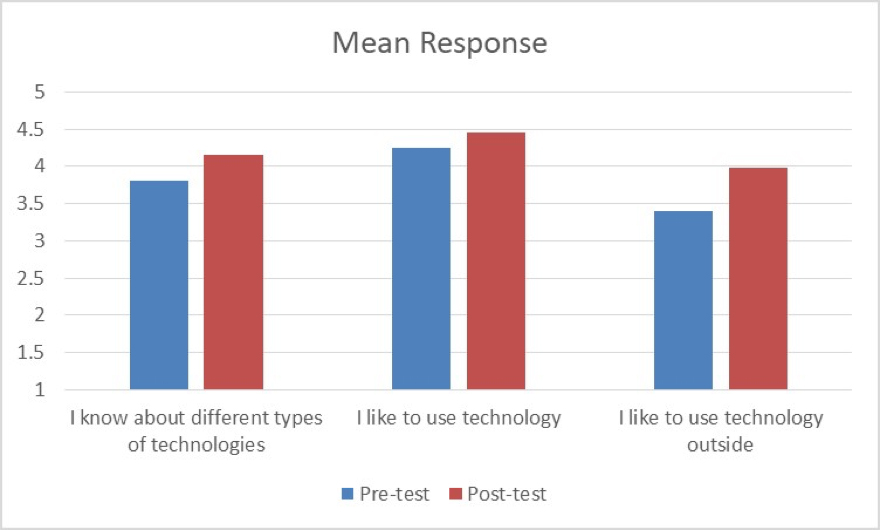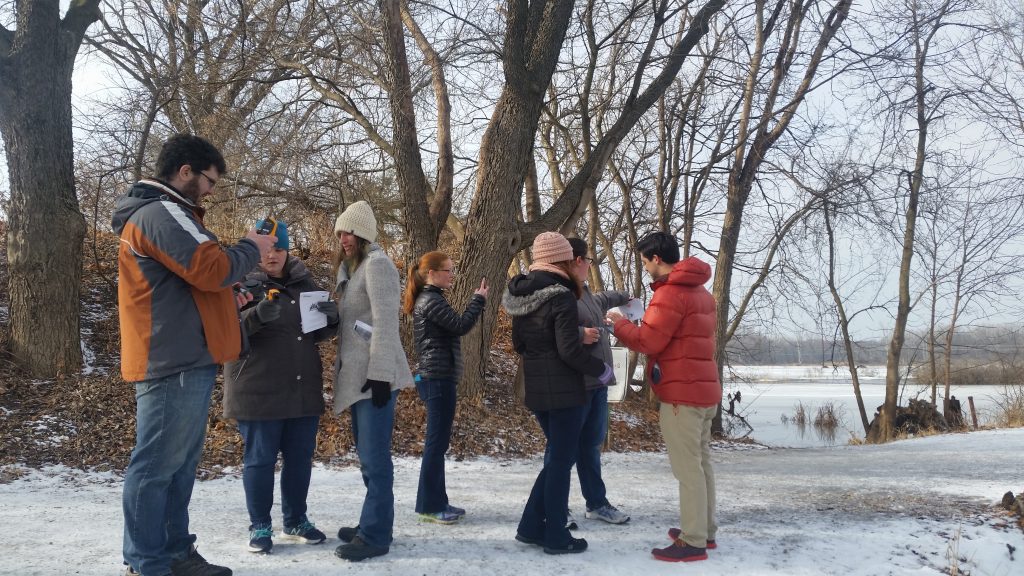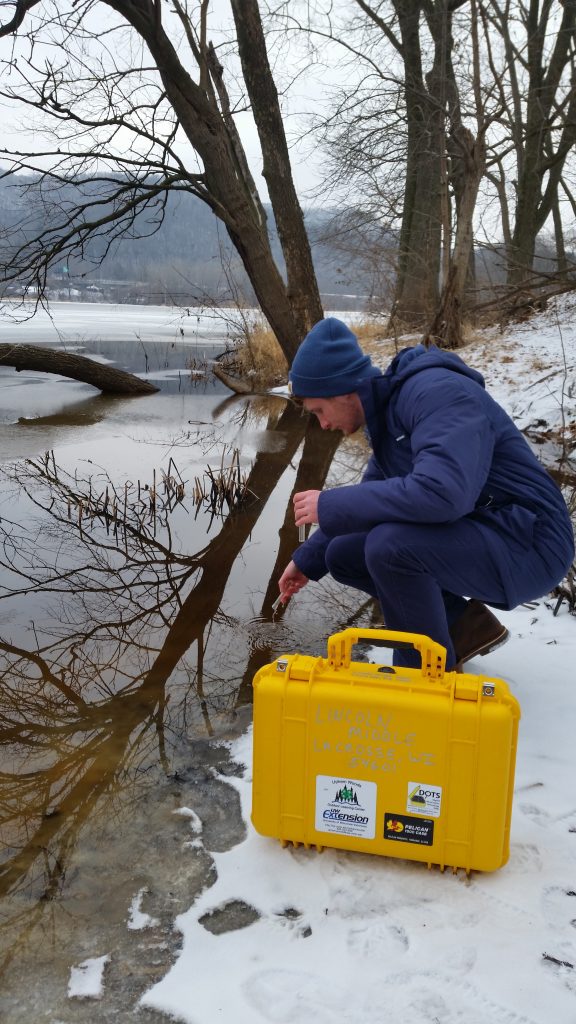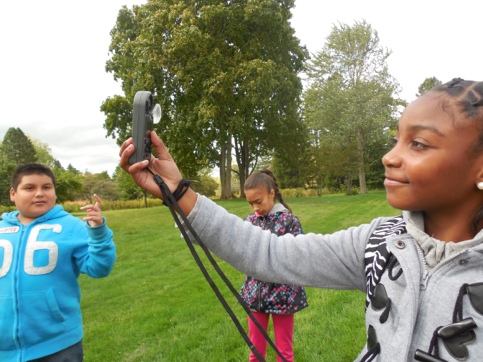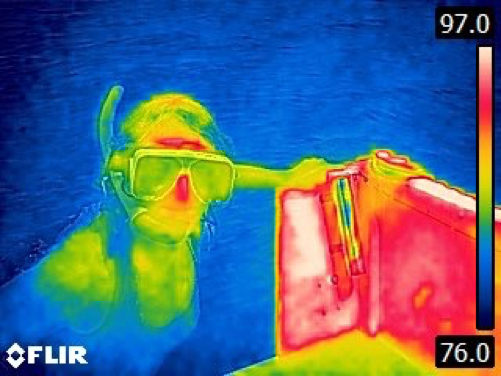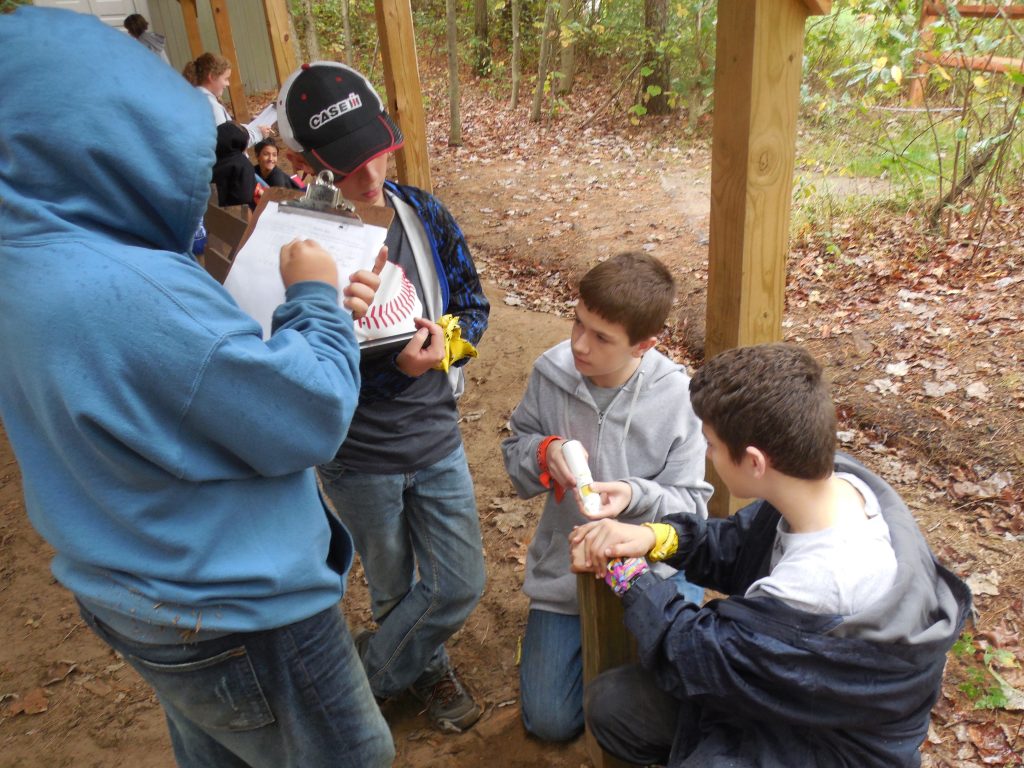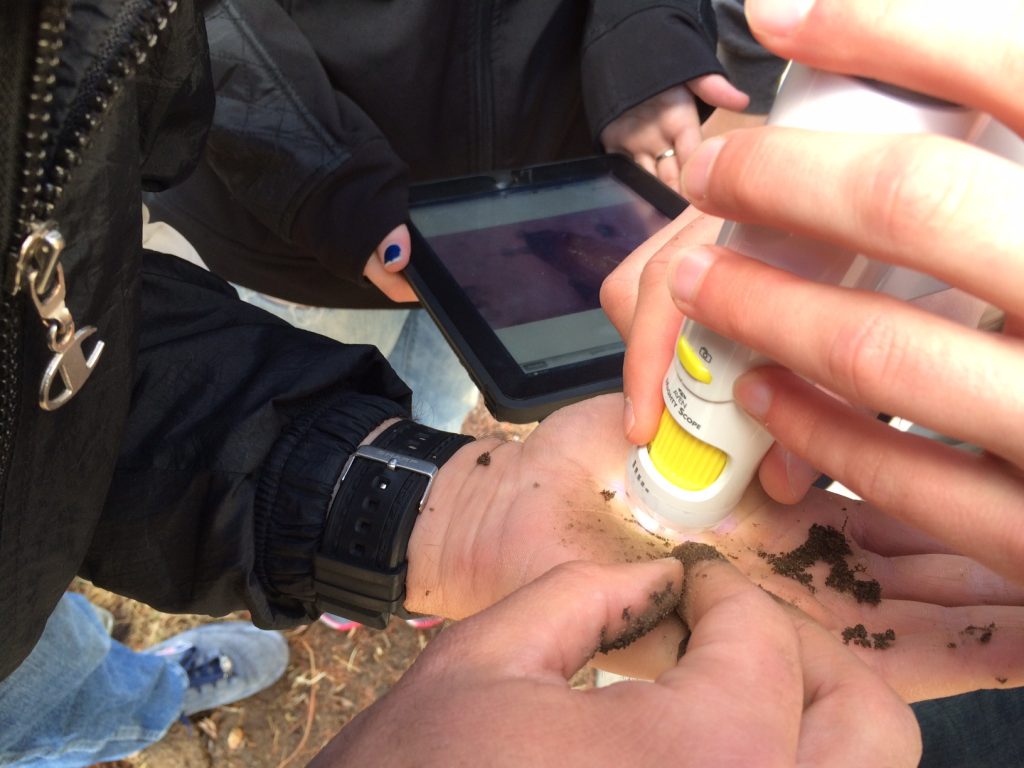Feature
Digital Observation Technology Skills
Incorporating Modern Digital Technology Into Outdoor Experiential Education
Connected Science Learning January-March 2018 (Volume 1, Issue 5)
By R. Justin Hougham, Marc Nutter, and Caitlin Graham
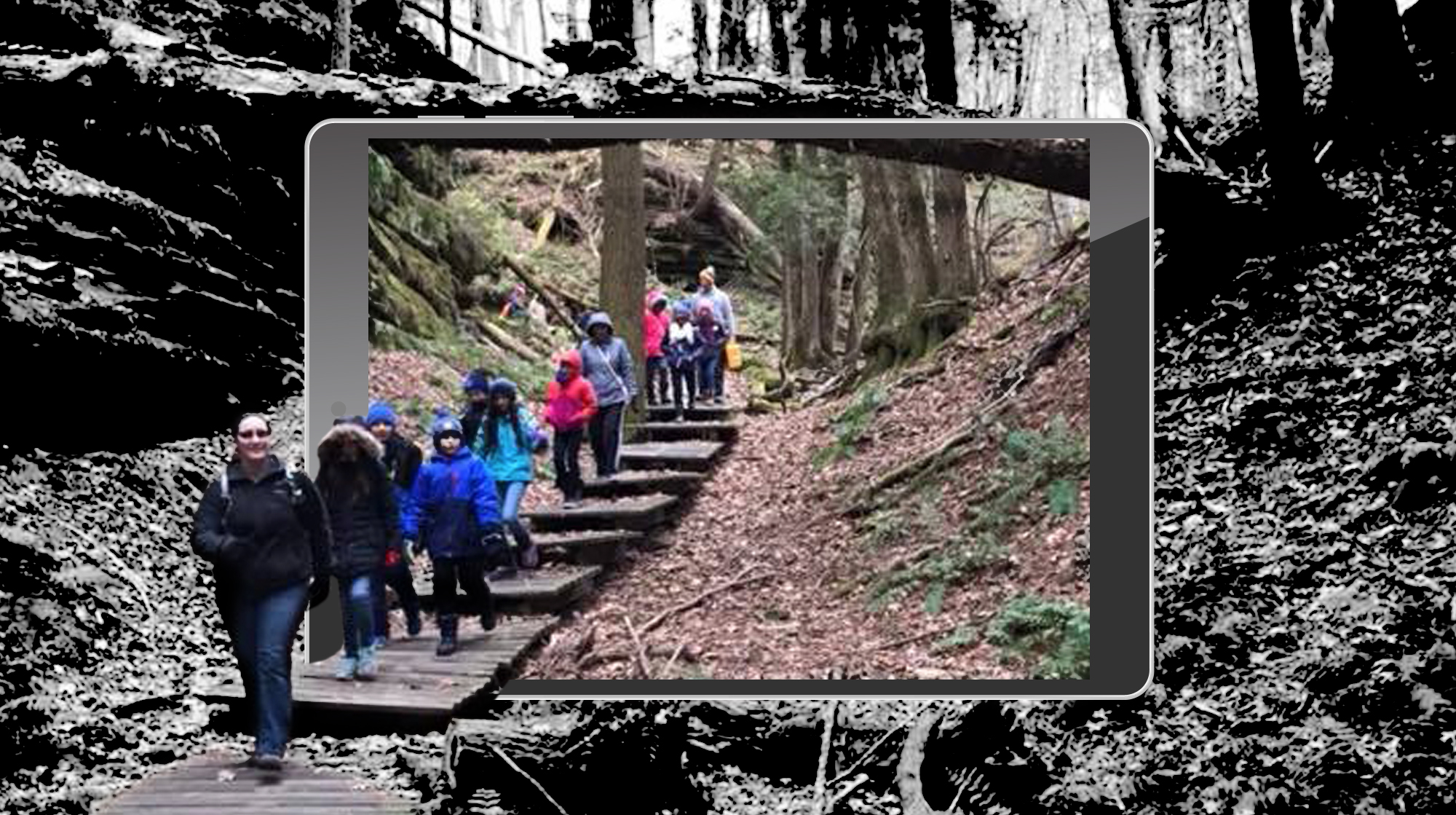
Digital Observation Technology Skills (DOTS) is a framework for integrating modern, mobile technology into outdoor, experiential science education. DOTS addresses longstanding tensions between modern technology and classical outdoor education by carefully selecting appropriate digital technology for educational purposes and by situating these tools in classical experiential pedagogy.
Practitioners of experiential, outdoor education, who primarily teach in informal science learning (ISL) settings, have seen extensive debate about the role of modern digital technology in their field. Some educators welcome education technology as a way to engage students, but others argue that they feel too much pressure to incorporate digital technology in their lessons without proper consideration for its role in learning goals. It’s true that as digital devices become more ubiquitous in students’ lives, educators face the task of reconciling modern technology with pedagogic practice. Today’s young learners have access to technology like autocorrect and spell check that make day-to-day life easier. This technology, however, may also impede an important learning process that occurs when students have to think through the editing process and make decisions about the clarity of their writing.
Researchers studying digital technology in outdoor, experiential education have raised concerns that the use of digital technologies can obstruct the learning processes that it is meant to facilitate and that it can be excessive and unnecessary for some educational activities (Cuthbertson, Socha, and Potter 2004; O’Connell and Dyment 2016). When digital technology is thoughtfully adopted and appropriately contextualized, though, it can be a tool to enhance learners’ engagement with the environment instead of an obstacle to effective pedagogic practice (Figure 1).
Figure 1
A young learner using a digital microscope and a tablet to observe microscopic details in sand
Researchers at Upham Woods Outdoor Learning Center (Upham Woods) have developed the Digital Observation Technology Skills (DOTS) framework to integrate mobile digital technology into outdoor ISL settings. DOTS was developed to ensure that the adopted technology will not detract from students’ learning experiences. The technology featured in the DOTS program was selected to meet several adoption criteria, detailed below in Table 1. The program itself is rooted in experiential pedagogy: It features classical observation exercises from Keri Smith’s How to be an Explorer of the World that scaffold scientific observation (Smith 2011). Because of these two considerations, the digital technology used in DOTS has the potential to expand the scope of learners’ observations and increase learner-driven inquiry.
Digital Observation Technology Skills
DOTS was developed in 2014 at Upham Woods, an ISL center in Wisconsin. The DOTS approach is made up of two features that facilitate the integration of technology into outdoor education: the DOTS kit, a set of portable mobile data collection tools that can be used outdoors (Figures 2 and 3); and the “Digging Deeper with Data” (DDD) online portal, an interactive website that allows DOTS users to upload data and see it represented in maps, tables, charts, and other formats. These features make up a pedagogic framework for ISL settings that enhances students’ data literacy, scientific observation, and scientific inquiry through integration of digital technology. In addition, these features create new avenues for collaboration between formal science educators and ISL practitioners to engage students in informal outdoor learning.
Figure 2
DOTS Kits combined with water quality tools: one of many variations on tools that can be included in these kits
The DOTS kit was the first feature of the DOTS approach to be developed. DOTS kits are portable sets of multi-parameter data collection tools that students use to observe, measure, and engage with their surroundings. All tools in the DOTS kits are carefully considered for usability and pedagogical appropriateness. Specific tools within the kits may change depending on user needs, but the considerations under which they were adopted remain consistent (Table 1).
DOTS kit users gain field experience with handheld weather stations, thermal imagers, digital field microscopes, and GPS units by collecting data to contribute to citizen science data sets (Hougham and Kerlin 2016). For a list of current tools used in DOTS, refer to Appendix A. These tools were selected based on utility, cost effectiveness, and ease of use. They were also selected because they provide concrete data points or digital artifacts for students to further reflect on after the data collection event. Most importantly, the tools are integrated into the pedagogic process in a way that facilitates deeper student engagement in outdoor education without acting as a distraction or barrier between learners and the outdoors.
To facilitate the integration of DOTS into formal classrooms, researchers aligned each DOTS tool with one of the Next Generation Science Standards, one of the Principles of Place Based Education, and a relevant external data set (NGSS Lead States 2013; Woodhouse and Knapp 2000). For example, the handheld weather station is suggested to be paired with the NOAA Climate at a Glance data set and used in a lesson plan aligned with NGSS: MS-ESS2-5 (Collect data to provide evidence for how the motions and complex interactions of air masses results in changes in weather conditions).
Learners use the tools in the DOTS kits to gather data and make observations when they’re in the field. They record their data and save the digital artifacts to use for reflection and inquiry. Then, they share their findings in the form of “scientific stories,” single-slide presentations that combine learners’ observations, data, hypotheses, and anything else they find interesting (Figure 4). The format of scientific stories allows them to be easily shared across digital platforms. More scientific stories can be viewed at the scientific story gallery on the DOTS website. The DOTS research team has adopted the term ‘digital artifacts’ to refer to the shareable products of DOTS data collection and visualization activities, from scientific stories to microscopic images. The generation of digital artifacts, such as thermal images and microscope screenshots, is an important consideration for digital technology adoption. Even technology that doesn’t produce a visual artifact but produces concrete data points can be used to create lasting data for students to reflect on after the initial data collection experience. Scientific stories and digital artifact preservation allow the DOTS framework to encourage students to move beyond observation and onto reflection and inquiry.
Figure 4
A scientific story that combines photos, GPS coordinate locations on a map, data from a lux meter and infrared thermometer, and student reflections
DOTS professional development for educators
The DOTS kits are accessible to educators through on-site programming at Upham Woods and through the DOTS kit lending program. The kit lending process includes support for users both before the lending event and throughout its duration. Before their first lending event, kit users attend a DOTS training session. See Appendix B for an agenda from a DOTS training session. DOTS trainings consist of two parts: an “indoor” segment (Figure 5) in which users are introduced to the DOTS tools, inquiry activities, and the theoretical background of the DOTS approach (i.e., inquiry-based, experiential, data-driven learning), and an “outdoor” segment, which takes users outdoors with the DOTS tools to engage in hands-on data collection and observation activities. Anyone interested in DOTS trainings can view an indoor portion of a DOTS training session in this video, filmed and broadcasted by Wisconsin Public Television.
After their initial training and throughout any kit lending event, DOTS users can access support resources on the DOTS website. These resources include lesson plans, technology troubleshooting guides, and how-to videos for all of the DOTS tools.
Digging Deeper With Data
After the DOTS kits were finalized, the DOTS approach gained a second major feature: the Digging Deeper With Data (DDD) website. The DDD site is an interactive data visualization portal that allows students and teachers to submit data they collect using DOTS kits and see it represented online in maps, tables, charts, and other formats. The site uses the Google Suite and the add-on application Awesome Tables to store and display student submitted data on the interactive web page. The DDD website is a collaborative effort between Upham Woods staff members who maintain its pages, collaborating educators who request features or formats for their unique learning goals, and participating students who upload their data by submitting entries in Google Forms.
The DDD website has been used to support both large and small data collection projects. Larger data collection projects see multiple collaborating educators working toward similar learning goals to produce large data sets on a given topic, like the ongoing EPA Water Monitoring Project. In projects like these, participating students submit their data through a single portal, allowing them to see how their own scientific observations compare to those of all other participating students. On the EPA Water Monitoring Project’s data collection page, for example, students across Wisconsin can see their own water quality data visualized alongside data collected by their peers all over the state (Figures 6 and 7).
Figure 7
Digging deeper with data: Data visualization from the ongoing EPA Water Quality monitoring project
In addition, the DDD website supports individual educators pursuing more localized or more specific learning goals. Staff at Upham Woods build individualized pages for these educators, like the DDD page built for La Escuela Fratney (Fratney), a Spanish/English dual language public school in Milwaukee that serves grades K–5. Many of the project pages on this site continue to support ongoing collaboration between Upham Woods, participating teachers, and their classes. Fratney’s page was originally created for a fall 2016 DOTS kit project. The participating teacher has since continued to use DOTS in the classroom beyond the fall 2016 semester, and the page is updated regularly by students and Upham Woods staff to display data from new classes of students (Figure 8).
Figure 8
A graph created on the DDD website from student-generated atmospheric data at Fratney Elementary
The DDD site is important to the success of the DOTS approach because it allows learners to reflect on and share their scientific observations beyond the data collection event. A platform to synthesize data and share artifacts allows DOTS learning to extend beyond simple observation. The use of digital technology outdoors is most beneficial to learners when it allows for experiences that would not have been possible otherwise. By collecting concrete data points and digital artifacts, students engage more deeply with their observations of their surroundings and environment.
DOTS case study: Connecting formal and informal science education
DOTS has allowed for more sustained and in-depth connections between formal classrooms and ISL settings like Upham Woods (Figure 9). While a significant portion of DOTS programming events have occurred through the kit lending process, some of the most successful DOTS projects have been a combination of ISL programming at Upham Woods and formal classroom instruction back at the students’ home institution.
One example of successful on-site DOTS programming is the ongoing collaboration between teachers from La Escuela Fratney and staff at Upham Woods. Fratney teachers use the DOTS framework to create in-depth research projects for their students first in their classrooms, then in daylong field trips around Milwaukee, and finally in biannual three-day trips to Upham Woods. The fall and spring trips to Upham Woods serve as a capstone field research experience for the dual language elementary students.
The Fratney students’ fall 2017 visit to Upham Woods allowed them to connect their classroom work to a new, outdoor environment. At school, they developed research questions to investigate during their three-day stay at Upham Woods. When they arrived onsite, they carried out data collection and explored the wilderness of Blackhawk Island (Figure 10). The banks of the Wisconsin River served as a new setting for the students’ data collection: many students recorded differences in environmental conditions between Upham Woods and their other sites around Milwaukee. Student-generated research topics included biodiversity in aquatic systems, microclimates under rocks, and energy loss in buildings.
On the last day of their trip, students presented the results of their data collection in groups at a data summit (Figure 11). They used PowerPoint, charts, bar graphs, and other data visualization techniques to enhance their presentations. The partnership between Fratney and Upham Woods has extended beyond their visits and has included in-class and out-of-class activity. One teacher from Fratney wrote, “[The collaboration] has allowed my students to use technology currently used in the workforce to explore the world around them, inquire, and share their science story in ways that I have not seen in my 15 years of teaching experience.”
Figure 11
Students from La Escuela Fratney present their findings to their peers as part of the data summit at Upham Woods using data they collected with DOTS tools
Safety is a priority in any on-site collaboration between ISL and formal classrooms. Classroom teachers that collaborate with Upham Woods in its ISL programming follow the NSTA Field Trip Safety Guidelines to ensure student safety outdoors. During the planning process, teachers work with students to establish learning objectives for their small groups, which reduces off-task behavior and increases student engagement. Students and teachers are accompanied by an Upham Woods staff member who is trained in first aid and has a firm understanding of the local learning opportunities and emergency action plans to ensure student safety and maximize place-based learning (Figure 12). Teachers follow guidelines set by NSTA and by Upham Woods to minimize risk of injury and maximize student engagement.
Figure 12
Students accompanied by Upham Woods staff member during a hike on Blackhawk Island during an Upham Woods field trip
Evaluating DOTS
DOTS was formally evaluated by a 2015 pilot study that assessed how successfully DOTS tools could be scaled for widespread use by school groups (Hougham et al. 2016). In addition, the DOTS teacher training method was evaluated in 2017 through a statistical analysis of post-training survey responses. These evaluations have provided preliminary data on the role of DOTS in student and educator experiences, but educators that use DOTS, including the Upham Woods Research staff, have identified several areas in which more thorough evaluation is necessary.
DOTS tool evaluation
The 2015 DOTS pilot study assessed the use of DOTS kits that were scaled to provide access to widespread audiences. The DOTS research team used a modified Common Measures instrument to examine student attitudes about using technology to learn outdoors (National 4-H Council 2015). The students surveyed had participated in lessons about plant biology that used a subset of the DOTS tools. Researchers surveyed students before and after the DOTS educational programming was integrated.
Research by Hougham, Nutter, and Graham (2018) measured the confidence and attitudes of youth ages 7–14 before and after a lesson involving classic and digital observation approaches.
An analysis of pre/post-test evaluation responses (n = 136) showed statistically significant positive shifts in student attitudes toward using technology and investigating nature after participation in the DOTS-integrated lessons (Figure 13). Specifically, students reported statistically significant differences in their knowledge of different technologies (p < 0.001), interest in using different technologies (p < 0.001), and the desire to use technology outdoors (p < 0.001). These shifts included changing the modal response in a five-point Likert scale from “neutral” (3) to “strongly agree” (5) in the case of their desire to use technology outside, and from a modal response of “agree” (4) to “strongly agree” (5) in the other two areas. Of the 12 survey questions, 5 questions did not result in statistically significant changes when the paired t-test was run on the experimental population. In many cases, these insignificant results were because students had already “agreed” or “strongly agreed” with the statements such as “I can use technology to learn” and “I care about nature” before the lesson occurred and their responses did not change afterward (Hougham et al. 2018).
Figure 13
Change in mean response to three Likert-style questions: 1 = Strongly Disagree and 5 = Strongly Agree
The positive survey results from the DOTS evaluation project suggest that the integration of technological components into a traditional outdoor lesson did not impede students’ experiences outdoors, although a research design limitation prevented the development of more thorough conclusions. Specifically, the study lacked a a group of students who could be surveyed after an equivalent lesson that did not include DOTS technology as a control group. The introduction of technology for only half of the students was deemed to have an unfair effect on students’ learning by a participating school system’s Internal Review Board. Therefore, to ensure equitable learning experiences, all of the students participating in the study experienced the technology-integrated lesson format, thus limiting the researchers’ ability to test the efficacy of the DOTS kits compared to similar student experiences.
DOTS teacher training evaluation
In 2017 the DOTS teacher training sessions (Figures 14 and 15) were evaluated through a statistical analysis of feedback surveys. A review of the training evaluation data from 53 adult educators included those from an off-site, five-day educator training (n = 13); three separate off-site, half-day adult educator trainings (n = 31); and an on-site, two-day educator training (n = 9).
It was found that 100% (n = 53) of all educators and area codes surveyed agreed or strongly agreed that they “better understand how science, technology, or engineering can solve problems after using the DOTS tools,” and 100% of respondents indicated that they would like to use DOTS kits again. All surveyed educators also said that they agreed (21%) or strongly agreed (79%) that they “liked learning about this subject,” (i.e., practices for using technology outdoors in science curricula). One educator expressed that he or she found the technology “interesting” because “you can use data to tell a story.” Another educator reflected, “I found it interesting that the different tools can help understand the state of an environment. The tools were also extremely easy to use, which was great.” Further evaluation should be conducted before and after trainings to better compare changes in educators’ attitudes regarding the use of technology outdoors. There is also potential for more extensive evaluation to compare DOTS-integrated lessons with lessons that use analogous tools so that researchers can isolate and examine the effects of the technology itself.
The DOTS program has worked with groups ranging from second grade through high school. DOTS-integrated programming has also been facilitated for adult learners, continuing education groups, and professional development groups. DOTS has reached over 6,000 people since its creation in October of 2014. The DOTS research team calls for further research on the adoption of technology in experiential education to better evaluate the effect DOTS has on participant engagement and STEM learning. Specific areas for further investigation include longitudinal impact, impact on student performance in STEM, and impact on student interest in scientific subjects and careers.
Figure 15
Educator using the water monitoring tools during an educator training hosted by the Wisconsin Society of Science Teachers
Discussion: DOTS and experiential science education
Aldo Leopold, a committed conservationist, understood the role technology could play in working toward environmental education rather than against it. His field emphasized being present in the outdoors without distractions. Environmental educators in Leopold’s era during the 1940s eschewed tools that would interfere with the relationship between a learner and the natural environment, and environmental destruction was attributed to modern technology. Leopold approached the topic with more nuance, saying in 1947, “I cannot avoid the conclusion that perhaps the only vicious thing in modern technology is the kind of people who wield its gadgets, and think they are civilized for this reason” (Meine and Knight 1999).
In this quote, Leopold also touches on the importance of adopting technology only when it is appropriate for the task at hand. Leopold’s considerations for adopting technology emphasize its role in enriching one’s connection to the natural world. The DOTS framework was developed with the same goals in mind. For instance, some outdoor educators in Leopold’s time criticized the camera as a distracting lens that impeded genuine wildlife appreciation. Leopold, on the other hand, believed that the camera could create a deeper connection to the object of observation by allowing for closer and further reflection. Although the types of technology considered “modern” have changed since then, the theory behind Leopold’s words remains relevant. Following his example, the DOTS framework has adopted modern technology in outdoor, experiential education for the purpose of enhancing students’ outdoor learning experiences and not just for the sake of the technology itself.
Figure 16
A student collecting atmospheric data: wind speed, humidity, air temperature, and pressure
The DOTS framework was created not to overhaul the groundwork on which outdoor experiential education rests, but to enhance it by bringing classical experiential education into the digital age (Figure 16). DOTS provides digital tools that widen the scope of student observations in ISL, while retaining the experiential qualities that encourage such observation. To facilitate this combination, DOTS engages three important themes in experiential science education: scientific observation, scientific inquiry, and scientific communication. It then adds to those themes a layer of digital and information literacy, STEM concepts that have become increasingly significant in the 21st century.
Scientific observation and inquiry
The practices of observation and inquiry are foundational to both classical outdoor education and modern STEM education. Classical outdoor education has historically emphasized, for example, taking a walk in the woods, orienting one’s senses toward natural processes, and asking questions about these processes. Similarly, modern STEM education emphasizes scientific inquiry via data collection, analysis, and research question formation. The DOTS framework bridges these two worlds by retaining the outdoor, experiential qualities of the former while expanding the range of observation (Figure 17) and allowing more thorough interaction with data collected.
The tools’ production of digital artifacts allows students to interact with the products of their observation activities long after the activities are over. Thermal imagers allow students to see thermal overlays of their surroundings, bringing to light a “layer” of information—temperature—that was previously invisible to them. (Figure 18). Students can plot temperature, wind speed, and humidity data on charts through the DDD portal and engage in more thorough analysis of what those observations mean.
The DOTS framework also functions as a bridge between classical experiential education and modern STEM education by scaffolding modern digital tool use with classical observation and inquiry exercises. All DOTS-integrated lessons that Upham Woods staff facilitate begin with exercises drawn from author and educator Keri Smith’s How to be an Explorer of the World (2011). One exercise, “Exploration #1: Right Where You Are Sitting” instructs the learner to quickly list 10 things they can see from where they are sitting that they had not noticed when they first sat down (Smith 2011, pp. 28–29). Simple observation exercises promote students’ use of digital tools to investigate interesting things they notice in their environment and form scientific questions about their observations. The observation exercises prime students to notice their surroundings and practice observing and reflecting on their observations. The DOTS tools then provide students with the means to take measurements and record these observations in a scientific way, while also expanding the range of what they can observe. In this way, the program as a whole scaffolds the scientific inquiry process.
Scientific communication
Scientific communication—the practice of sharing the results of one’s observation and inquiry activities—is essential to most STEM curricula (Figure 19). Educators emphasize scientific communication to encourage their students to critically reflect on their own activities and to engage with their peers’ work. The DOTS framework’s inclusion of scientific stories and data visualization on the DDD website provides opportunities for educators to scaffold learners’ scientific communication skills. Both of these features draw from the concept of citizen science: the practice of engaging the average person, with no special qualifications, in activities that contribute data to larger bodies of scientific knowledge (Hougham and Kerlin 2016). Citizen science serves as a way for young learners, who may feel intimidated by complex scientific themes, to engage with scientific concepts through tasks as simple as birdwatching (Blount 2017).
The DOTS framework situates mobile data collection tools in a more comprehensive science education experience: students go outdoors, make environmental observations, use DOTS tools to record data related to those observations, and use the DDD portal to reflect on and synthesize those observations. DOTS users upload their data onto the DDD website, contribute to a larger pool of data, and can see their data visualized alongside that of their peers. They can then compare that data set with online data sets collected by scientists, such as the NOAA Climate at a Glance data, to evaluate their work. This data visualization platform allows students to reflect on the scientific process. When students produce scientific stories from data they collected themselves, they interact with those findings on a deeper level.
Digital and information literacy
Information literacy, the ability to “recognize when information is needed and … locate, evaluate, and use [it] effectively,”is an interdisciplinary skill emphasized in STEM curricula (American Library Association 1989). The rise of digital technology and communications has provided users with faster access to more of this information than previously possible. As such, information literacy has taken on a digital component: digital literacy, the ability to “use information and communication technologies to find, evaluate, create, and communicate information” (Visser 2012). These overlapping skills are critical to STEM pedagogy in the 21st century.
The DOTS framework is, in part, a response to calls for technological advances to experiential science education. DOTS was constructed with digital and information literacies in mind. Incorporating technology into science education necessitates the incorporation of skills that allow learners to understand and evaluate the tasks that use that technology.
DOTS data collection activities provide students with hands-on experience in information creation and evaluation. Instead of giving students preexisting data or textbook descriptions of scientific findings, DOTS puts data collection tools in the learners’ hands and challenges them to produce a brand-new data set with which they can investigate scientific concepts (Figure 20). Student interaction with data doesn’t end when they put away the DOTS kits. DDD sites give educators several opportunities to push students’ reflections further. Educators from La Escuela Fratney, from the case discussed earlier in this article, use the DDD site for student reflections that then become artifacts in presentations and in a science fair. The practice of creating scientific stories also facilitates reflection and inquiry.
Conclusion
The DOTS framework was developed to enhance outdoor, experiential education by building on its core tenants of observation and inquiry while adding new digital dimensions to its reach. DOTS tools enhance experiential education not because of an inherent quality of the tools selected, but rather because of the careful consideration with which the tools were adapted to the learning tasks. The tools selected expand the range of what students can observe without being distracting or excessive. The DOTS research team emphasizes the importance of only adopting the minimum necessary tool to allow the user to complete a task that would otherwise be inaccessible.
DOTS researchers situated digital technology within classical experiential pedagogy to maintain the inquiry-driven nature of experiential education while incorporating 21st-century learning goals, like digital literacy. The skills of observation and reflection are as relevant as ever in science education, even in the technology-saturated 21st century. DOTS equips learners with digital tools in a way that emphasizes and expands these vital scientific skills.
R. Justin Hougham (justin.hougham@ces.uwex.edu) is associate professor of environmental education and the director of the Upham Woods Outdoor Learning Center at the University of Wisconsin–Madison Division of Extension in Wisconsin Dells, Wisconsin. Marc Nutter (marc.nutter@ces.uwex.edu) is the facility director for Upham Woods Outdoor Learning Center and assistant professor at University of Wisconsin–Extension in Madison, Wisconsin. Caitlin Graham (caitlin.graham@ces.uwex.edu) is a research naturalist at Upham Woods Outdoor Learning Center and assistant professor at University of Wisconsin–Extension in Madison, Wisconsin.



